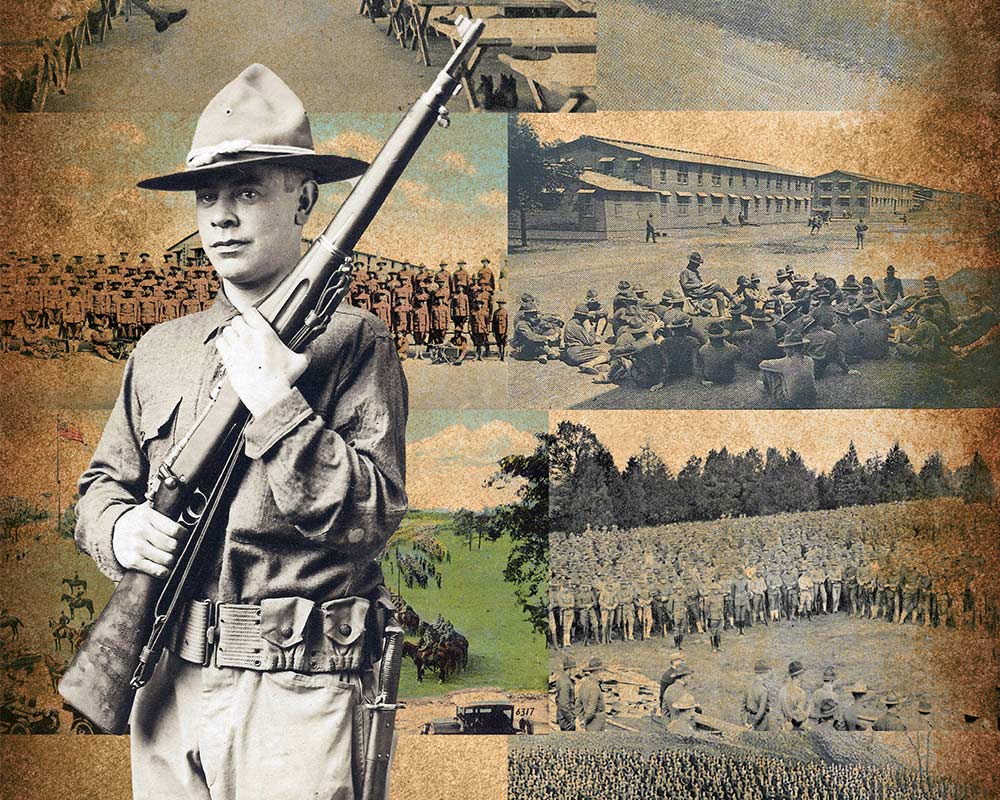Midway Village Museum is developing a new permanent exhibit to tell the story of Rockford’s Camp Grant and is in the process of collecting artifacts, stories, and funds to move the plans forward.
“You’re In the Army Now: Camp Grant, Rockford’s Legacy,” is the name of the permanent exhibit that will be housed in a 2,500-square-foot exhibition hall at Midway Village Museum, 6799 Guilford Road.
“Camp Grant is a fundamental part of Rockford history and the city changed so much because of Camp Grant. It’s meaningful to the veterans, their friends, families and the entire community. So, those stories and artifacts should be preserved and displayed at Rockford’s history museum, which is Midway Village,” says Luke Fredrickson, marketing director for the museum.
The exhibit will include conceptual designs that tell the story of Camp Grant on a timeline, first person stories, family stories, and artifacts, including a rare bugle recently donated, in top condition. Early this spring, Midway Village announced it was looking for family stories and/or artifacts and encouraged people to add them to the Camp Grant collection by visiting the museum’s website at midwayvillage.com. All photos will be scanned and digitalized and will also be on the website.
Early in the summer, the museum announced its launch of a capital campaign to fund the construction of the future exhibit. A fundraising goal of $525,000 was established to allow for design, curation and construction of the exhibit. To date, about $150,000 has been raised and a total of $350,000 is needed to begin construction, hopefully by next fall, he says.
The collection got off to a good start when the former Command Post Restaurant closed its doors in 2020 and auctioned off its hundreds of Camp Grant photographs, documents and artifacts, all bought by the museum.
“We are very thankful the family-owned business did such a great job of preserving the artifacts they had on display in the restaurant. And we’ve gotten a good response from our call for artifacts and have raised enough money to begin the exhibit design,” Fredrickson says.
The museum’s mission statement is to collect, preserve and interpret the history of the Rockford region, so people can understand how the events of the past were meaningful at the time and how it impacts life in Rockford today. The museum’s LZ Peace Memorial on five acres is a project of the Vietnam Veterans Honor Society and was dedicated on Memorial Day 2005. A Huey Helicopter rests above the wall listing the names of area residents who died in the war.
The Camp Grant stories and artifacts will also leave a lasting impression. Veteran groups, especially, have shown their support and enthusiasm for the museum’s work, demonstrating the importance of remembering the past, Fredrickson says.
“I’ve learned how much Camp Grant has changed Rockford over the past 100 years. It was a boom to the economy when it was built in 1917 and then expanded during World War II. Buildings and roads were built using local labor and supplies and many of the soldiers who came to Rockford ended up staying here and added to the diversity of the community. Rockford would have been dramatically different without Camp Grant,” Fredrickson says.
As the United States entered World War I in 1917, the government built 16 Army Infantry Training Camps. The Rockford Chamber of Commerce campaigned for one to be placed in Rockford, and the result was Camp Grant, built five miles south of downtown on property that is now owned by the Rockford Chicago International Airport, and includes portions of New Milford Village and Atwood Park.
Construction of the camp led to better roads, land development, and an expansion of public services in Rockford. Camp Grant had trenches for infantry training, medical facilities, recreation buildings and hundreds of barracks. It provided thousands of jobs, served as a rallying point for local support of war efforts, and forever impacted the demographics of the community.
During World War I, tens of thousands of recruits trained at the camp, and thousands more were discharged there. Particularly notable was the arrival of 6,000 African-American soldiers, a dramatic demographic shift for the region. At the time, the Rockford community had only 200 Black residents.
Much of the camp was dismantled after World War I, and what remained was used by the Illinois National Guard and the Civilian Conservation Corps. However, the onset of World War II saw Camp Grant reactivated with more than 300,000 soldiers passing through its gates, mainly to train medical personnel and house prisoners of war.
In 1948, the camp was turned over to the city of Rockford. ❚
















